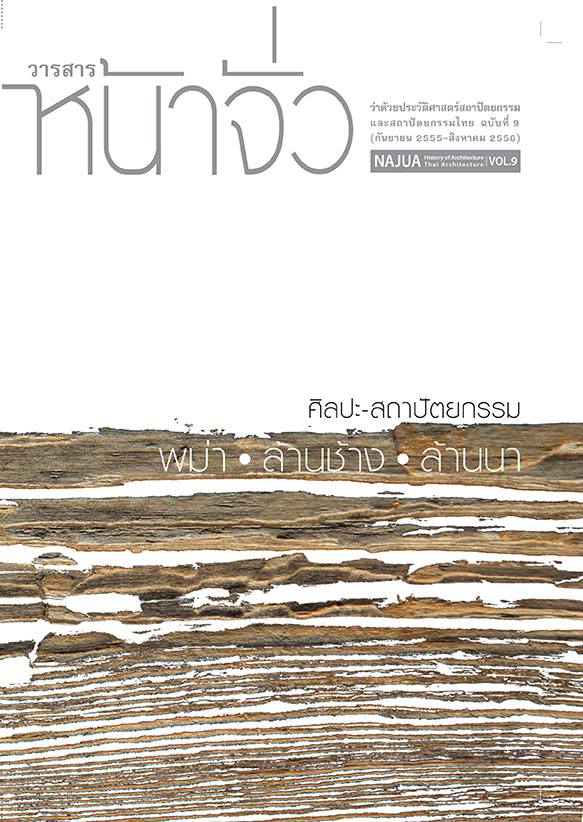ประเด็นวิกฤตเรื่องการอนุรักษ์ชุมชนประวัติศาสตร์ในเมืองสำหรับประเทศไทย Critical Issues on the Conservation of Historic Urban Community for Thailand
Main Article Content
Abstract
บทคัดย่อ
การอนุรักษ์แหล่งมรดกวัฒนธรรมในประเทศไทย แต่เดิมเน้นที่โบราณสถานประเภทวัด วัง ซากปรักหักพังแหล่งโบราณคดี หรืองานสถาปัตยกรรมที่มีความเป็นเลิศ แต่ในช่วงสองทศวรรษที่ผ่านมาได้มีกระแสของการอนุรักษ์ชุมชนดั้งเดิมหรือชุมชนประวัติศาสตร์ โดยเฉพาะที่สำคัญคือที่ตั้งอยู่ในเขตเมือง อย่างไรก็ตามการอนุรักษ์ชุมชนดังกล่าวยังอยู่ในลักษณะต่างคนต่างทำ ไม่มีกรอบการดำเนินงานหรือการส่งเสริมจากรัฐบาลทั้งส่วนกลางและส่วนท้องถิ่นที่ชัดเจน ส่วนใหญ่เน้นในเรื่องของการส่งเสริมการท่องเที่ยว ซึ่งเชื่อกันว่าจะทำให้เศรษฐกิจของชุมชนดั้งเดิมที่ซบเซานั้นสามารถฟื้นฟูขึ้นมาได้ ในขณะที่องค์ประกอบที่จับต้องได้ของชุมชน คือ อาคาร และโครงสร้างทางกายภาพของชุมชนค่อยๆ เปลี่ยนแปลงไปทีละน้อย และมีแนวโน้มที่จะสูญสลายไปในที่สุด จึงเกิดคำถามว่าในประเทศไทยนั้นมีชุมชนดั้งเดิมในเขตเมืองจำนวนเท่าใด และจะมีแนวทางในการรักษาสิ่งที่มีคุณค่าในชุมชนซึ่งมีทั้งอาคาร สิ่งก่อสร้าง และวิถีชีวิตไว้ได้อย่างไร จากการสำรวจชุมชนประวัติศาสตร์ในประเทศเบื้องต้นจำนวน 140 แห่ง ใน 54 จังหวัด พบว่าส่วนใหญ่มีพัฒนาการตั้งแต่สมัยรัชกาลที่ 5 อันเนื่องมาจากการพัฒนาเส้นทางคมนาคม ได้แก่ ทางรถไฟและทางเรือที่ขยายไปยังส่วนภูมิภาค และเมื่อได้ทำการศึกษารายละเอียดชุมชนนำร่อง 4 แห่ง พบว่าผู้อยู่อาศัยในชุมชนต้องการที่จะอนุรักษ์ทั้งอาคารและวิถีชีวิตไปพร้อมกัน แต่ไม่มีกรอบการดำเนินการจากภาครัฐ รวมทั้งยังมีปัญหาในด้านความซับซ้อนของกรรมสิทธิ์ในทรัพย์สิน การทำลายชุมชนจากโครงการพัฒนาของรัฐที่ขาดธรรมาภิบาล การขาดเงินทุน วัสดุ และวิธีการในการอนุรักษ์อาคาร เมื่อศึกษาเปรียบเทียบกับกรณีศึกษาในต่างประเทศ พบว่าการอนุรักษ์ชุมชนประวัติศาสตร์ที่ประสบความสำเร็จนั้น มาจากการริเริ่มของประชาชนและท้องถิ่น ซึ่งต่อมารัฐบาลกลางได้เห็นความสำคัญและปรับปรุงกฎหมาย เพื่อให้อำนาจท้องถิ่นสามารถประกาศย่านประวัติศาสตร์เองได้ พร้อมทั้งการจัดหามาตรการแรงจูงใจทางเศรษฐศาสตร์ ซึ่งในประเทศไทยยังไม่ได้มีการดำเนินการในเรื่องดังกล่าว
Abstract
During the past two decades, there has been a movement on the conservation of small historic urban communities which is different from the national conservation mainstream on ancient monuments and archaeological areas. However, the conservation of most of those historic communities does not receive a clear attention or promotion from the both central and local governments. Most of the government supportive activities are in the form of cultural tourism to revive the declined local economy while the important physical elements in the community are neglected, leading to the disappearance of historic buildings and urban form. This paper examines and identifies the existing 140 historic urban communities in 54 provinces in Thailand through the rapid survey and selects 4 communities for the detail study. Most of the historic communities share their origins as a result of the construction of regional railways and waterways during the reign of King Rama V (1868-1919). The selection of 4 communities is based on willingness of the residents to preserve the buildings and the intention to undertake the conservation action in the future. Through the consultation process, it is found that the 4 communities would like to conserve both the buildings and way of life but there is no proper guidance from the government. Threats to historic communities include the government’s infrastructure development projects, complicacy of tenure and property ownerships, and shortage of conservation resources in terms of finance, construction materials as well techniques. The case study from foreign countries that have mechanisms in conserving small historic urban communities shows that the successful conservation of historic urban communities come from the demand of the local residents together with local government, leading to the subsequent improvement of legislation from the central government to enabling the local and citizens to launch the conservation program on their own efforts with available supports and incentives. It is unfortunate that there is no such provision in Thailand and thus has become the current critical issue for those who would like to conserve their own communities.

